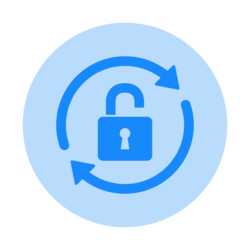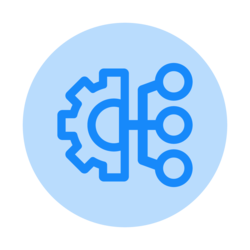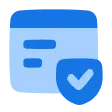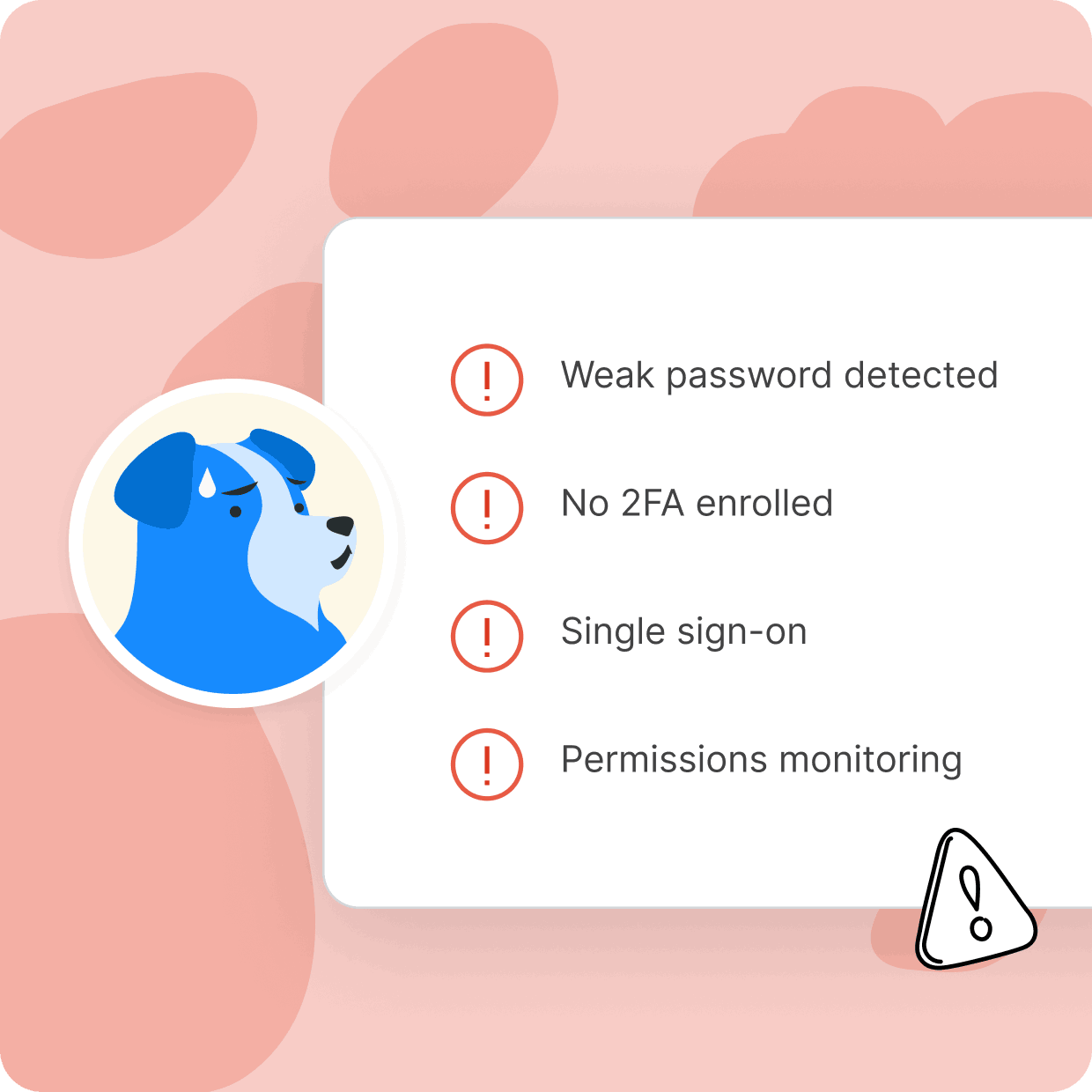A SaaS security solution refers to a software-as-a-service platform that is specifically designed to protect and secure cloud-based applications and data. It offers various security features, such as encryption, access controls, threat detection, and monitoring, to safeguard sensitive information and defend against cyber threats within the SaaS environment.
Unfortunately, many applications don't support identity standards like the Security Assertion Markup Language (SAML) and the System for Cross-domain Identity Management (SCIM) specification. Without native support for these standards, applications either can't work with many identity provider solutions or require expensive integrations.
Cerby allows you to manage all your SaaS administrator accounts, rotate credentials, and monitor and audit privileged account activities.
Secure Privileged Accounts
Not all accounts are created equal. Some come with administrative permissions that put sensitive data at risk when in the wrong hands. With Cerby, you can help protect your business from bad actors, mistakes, and data breaches.
With Cerby You Can

Secure your SaaS admin accounts

Protect your business from data breaches

Eliminate the costs of custom integrations
SaaS Security Solution
In today’s increasingly digitized world, businesses must rely heavily on cloud-based applications and services in order to streamline their operations and deliver a seamless user experience. However, this increased dependence on SaaS introduces new security challenges that organizations must carefully address. That’s why SaaS security solutions play such an integral role in safeguarding cloud-based applications and data from various cyber threats.
But what is SaaS, exactly? And why is it important? SaaS stands for “software as a service,” and the term refers to a cloud computing model where software applications are hosted and provided to users via an Internet connection. Instead of installing software on individual computers or servers, users can access SaaS applications through most web browsers, which saves both time and valuable resources.
As businesses and organizations entrust their sensitive data to cloud-based SaaS platforms, the need for robust SaaS cybersecurity solutions becomes ever more apparent. These solutions encompass a broad range of measures and technologies designed to help protect SaaS applications and data from unauthorized access, data breaches, and other cyber threats.
One of the most important parts of SaaS security is ensuring secure access to various SaaS applications. This may involve implementing strong authentication mechanisms (like multi-factor authentication, for instance) to verify a user’s identity and prevent unauthorized access. Encryption techniques can also help ensure the secure transmission and storage of data within the SaaS environment.
Additionally, SaaS security solutions incorporate comprehensive monitoring and threat detection capabilities. They employ advanced algorithms and machine learning to identify suspicious activities or user behavior, detect potential breaches, and respond in real time. By continuously monitoring things like user behavior, network traffic, and application logs, a SaaS security solution platform can swiftly identify and mitigate a number of security incidents. And as businesses continue to embrace the many benefits of SaaS, they must also invest in reliable security solutions to help safeguard sensitive information and maintain secure digital operations.
SaaS Risks
When an organization makes use of a SaaS application, the organization exposes itself to a range of SaaS risks and security challenges that require comprehensive solutions. Because of this, understanding SaaS security risks is essential for maintaining a secure digital environment.
According to the Ponemon Institute research, organizations are not able to reduce the cybersecurity risks caused by shared accounts. In the research, 50% of respondents say their organizations’ access management strategy enables employees to share login credentials securely when required by the application.
One of the most prevalent SaaS security risks is data breaches. Storing sensitive information in the cloud increases the potential for unauthorized access, especially if proper security measures are not in place. Breaches can lead to severe consequences, including gross financial loss, reputational damage, as well as legal liabilities.
Another SaaS concern involves the lack of control over infrastructure and data. Organizations may rely heavily on SaaS providers to help manage their applications and data, which means they must trust the provider’s security practices. In some cases, however, this lack of control can increase the risk of data loss, service outages, or data leakage if the provider’s security measures are inadequate or overcome by persistent cyber criminals.
SaaS integration challenges also pose a number of security risks. Integrating SaaS applications within existing systems and workflows requires a careful and thorough consideration of security protocols and access controls. If not properly managed, integration can inadvertently create one or multiple vulnerabilities that attackers can exploit. Addressing SaaS security issues is crucial for organizations to protect their cloud-based applications and sensitive data effectively.
SaaS Security Best Practices
Implementing and maintaining a secure SaaS environment will require strict adherence to SaaS security best practices, beginning with a comprehensive SaaS risk assessment and following up with continuous monitoring and updating of SaaS security controls.
Firstly, organizations must conduct a thorough SaaS risk assessment to identify and evaluate potential risks and vulnerabilities of the SaaS environment. This will require an assessment of the security controls provided by the SaaS vendor, a comprehensive understanding of the data handling process, and identifying any missed compliance requirements.
When the risks have been identified and tallied, the organization must then implement the appropriate SaaS security controls. These controls encompass measures like strong authentication mechanisms, access controls, data encryption, and regular security updates. Organizations should also enact clear security policies and provide guidelines for user behavior expectations, data classification, and incident response protocols.
In addition to structural security measures, employee awareness, and training are also vital components of SaaS security best practices. Educating users about various security risks, best practices for password management, and safe browsing habits can substantially reduce the likelihood of data breaches or other successful cyberattacks.
By following these best practices, organizations can significantly enhance the security posture of their SaaS environment by protecting sensitive data and effectively mitigating the risks associated with cloud-based applications.
SaaS Security Assessment
With a SaaS risk assessment template or a SaaS security checklist, improving an organization’s SaaS security posture becomes much more manageable. These efforts can help organizations evaluate the effectiveness of security measures, identify any vulnerabilities, and align with industry best practices and other relevant standards.
A SaaS security assessment involves a systematic evaluation of the security controls and practices that have been implemented inside the SaaS environment. The assessment will examine data protection initiatives, access controls, authentication mechanisms, encryption capabilities, incident response, as well as compliance requirements.
SaaS risk assessment templates also provide a structured framework to help understand the risks associated with the SaaS environment. The templates often include predefined categories and questions that cover a broad range of important security considerations. By leveraging such templates, organizations can ensure a comprehensive evaluation of their SaaS security landscape and ensure that all bases are covered.
Similarly, a SaaS security checklist can be an invaluable reference for organizations seeking to improve their SaaS security posture. These checklists outline primary security concerns, controls, and other requirements that ought to be in place for a more secure SaaS environment.
Complying with applicable standards and regulations can bolster the security of an organization’s SaaS environment, ensuring the protection of sensitive information and mitigating the potential risks involved.
SaaS Security Architecture
Well-designed security architecture is a necessity when building a resilient SaaS security solution. Security architecture establishes the framework for implementing effective security controls and ensuring the confidentiality, integrity, and availability of SaaS applications and their data.
SaaS security architecture encompasses the design and integration of certain security elements such as network infrastructure, identity and access management, encryption mechanisms, and monitoring systems. It considers all of the idiosyncrasies and risks of the SaaS environment and provides a systematic approach to addressing various security concerns effectively.
Organizations can leverage a SaaS security framework as well to help develop guidelines, best practices, and a common set of controls. These frameworks can help business organizations align with industry-recognized standards and establish a robust security foundation.
Even using a SaaS security checklist can help organizations implement better security measures that are more closely aligned with the needs of their SaaS environment.
By adopting a well-thought-out security architecture and implementing security frameworks and checklists, organizations can establish a comprehensive SaaS security solution. This approach will provide a systematic and standardized method of addressing security requirements, mitigating risks, and aligning with industry-recognized SaaS security standards.
Cloud Security Vendors
The market of cloud security vendors is inundated with the top SaaS security companies offering comprehensive solutions to help safeguard cloud-based applications and sensitive data. These leading SaaS security vendors provide numerous features and resources that are engineered to address the unique security challenges facing cloud environments.
Cloud security vendors like Palo Alto Networks, McAfee, Cisco Systems, and Fortinet offer robust cloud security solutions that cover several aspects of SaaS security. These solutions usually include features that help with visibility, compliance monitoring, data loss prevention, encryption, and threat detection.
Additionally, well-established tech companies like Microsoft, Proofpoint, and Trend Micro offer more specialized SaaS security solutions. These SaaS security companies are well-known for their expertise, innovation, and ability to address the evolving security needs of organizations that rely on cloud-based solutions.
You could compare the top 10 cloud security companies and find numerous features of each one that would support security posture improvement initiatives at your organization. By leveraging these solutions, businesses can greatly enhance the security of their SaaS environments while protecting sensitive data and mitigating the risk of cyber attacks.
SSPM Vendors
In the SaaS security industry, emerging trends and new innovations help shape the landscape and provide organizations with new tools and strategies to stay one step ahead of cybercriminals.
One notable trend is the increased popularity of SaaS security posture management (SSPM) initiatives. SSPM solutions aim to provide greater visibility, compliance monitoring, and risk assessment across multiple SaaS applications.
These platforms help paint a clearer picture for organizations seeking to gain insights into their overall SaaS security posture. SSPM vendors offer features like continuous monitoring, automated risk assessments, and centralized management capabilities, which means companies have all the tools they need to proactively address any pressing security issues.
By embracing SaaS security considerations, understanding the nuances between SSPM vs. CASB, and implementing proactive security strategies, organizations can ensure that they stay ahead of potential threats in the SaaS environment while significantly improving their security posture. This allows companies to better protect sensitive information, mitigate cyber risks, and ensure the integrity and availability of their cloud-based applications.
